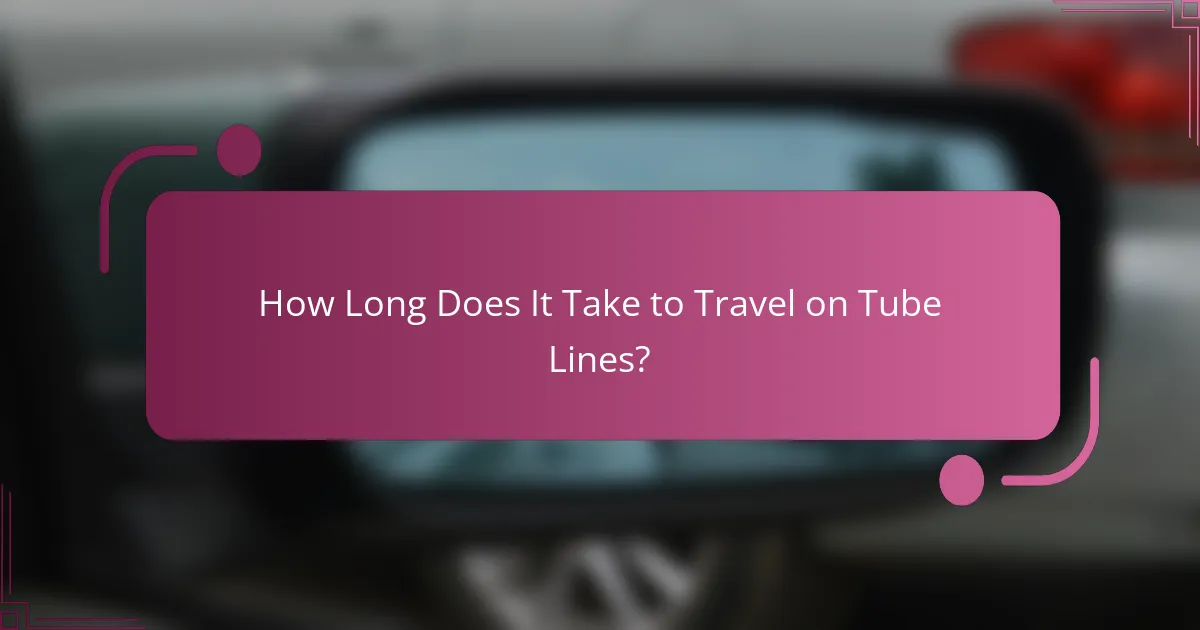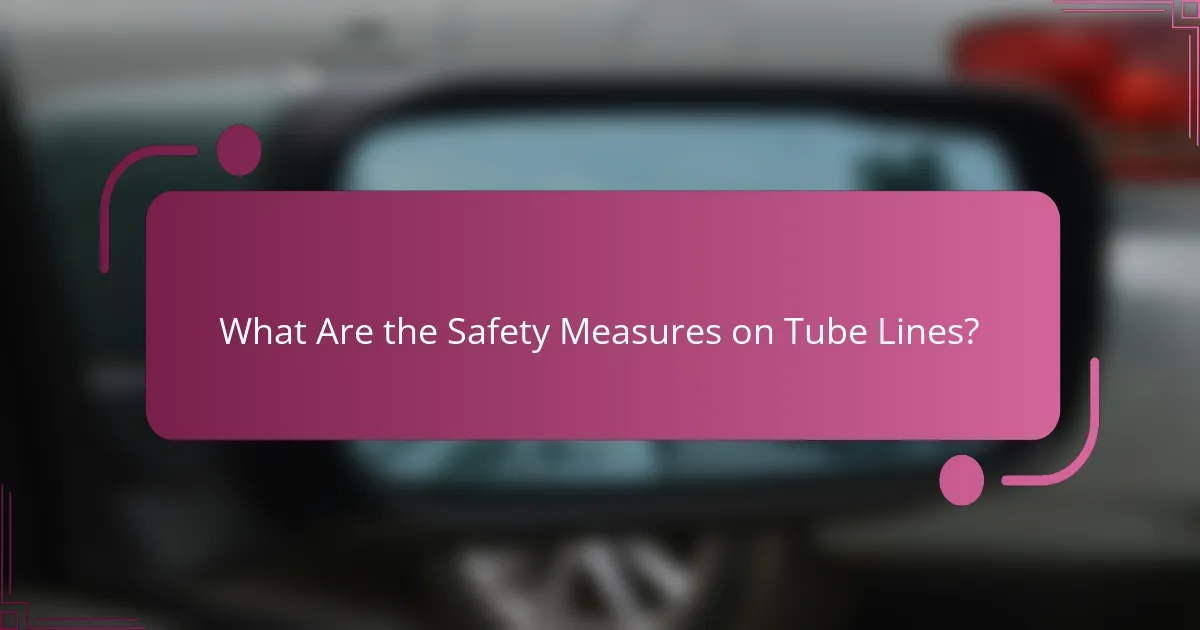London’s Tube lines are a vital resource for tourists, with the Bakerloo, Piccadilly, Central, District, and Jubilee lines providing direct access to key attractions and historic sites. Travel times typically range from a few minutes to over an hour, with most central journeys averaging 15 to 30 minutes. This efficient transport system allows visitors to easily explore iconic landmarks such as the British Museum, Tower of London, and Westminster Abbey.

What Are the Most Popular Tube Lines for Tourists?
The most popular Tube lines for tourists in London include the Bakerloo, Piccadilly, Central, District, and Jubilee lines. These lines connect key attractions and historic sites, making them essential for navigating the city efficiently.
Bakerloo Line
The Bakerloo Line is known for its accessibility to major attractions like the London Eye and the West End theatres. It runs from Harrow & Wealdstone in the north to Elephant & Castle in the south, making it a convenient choice for visitors.
Travelers should be aware that the Bakerloo Line can be crowded during peak hours, especially on weekends. It’s advisable to plan trips during off-peak times for a more comfortable journey.
Piccadilly Line
The Piccadilly Line is a vital route for tourists, linking Heathrow Airport to central London and popular destinations like the British Museum and Covent Garden. It operates from Heathrow in the west to Cockfosters in the north.
Travelers should consider purchasing an Oyster card or a contactless payment card for easy access. The line can experience delays, so checking live updates before traveling is recommended.
Central Line
The Central Line runs through the heart of London, connecting attractions such as Oxford Circus and the Museum of London. It stretches from West Ruislip to Epping, making it one of the longest lines in the network.
Due to its extensive coverage, the Central Line can be a busy route. Visitors should be prepared for potential delays and plan their journeys accordingly, especially during rush hours.
District Line
The District Line serves a variety of key sites, including the Tower of London and the Houses of Parliament. It runs from Upminster in the east to Wimbledon in the southwest, providing access to both central and suburban areas.
Travelers should note that some trains on the District Line may not run all the way to their final destinations, so checking the service updates is crucial. This line is particularly useful for reaching attractions in the West End and South Kensington.
Jubilee Line
The Jubilee Line is a modern line that connects important locations such as the O2 Arena and Canary Wharf. It runs from Stanmore in the northwest to Stratford in the east, making it a key route for both business and leisure travelers.
This line is generally less crowded than others, especially during off-peak hours. However, visitors should still check for any planned engineering works that might affect service, particularly on weekends.

How Long Does It Take to Travel on Tube Lines?
Traveling on London Tube lines typically takes anywhere from a few minutes to over an hour, depending on the distance and the specific route. Most journeys within central London average around 15 to 30 minutes, making the Tube a convenient option for tourists.
Average Travel Times
Average travel times on Tube lines vary based on the distance between stations and the specific line used. For example, a trip from Westminster to Covent Garden takes about 2 minutes, while longer journeys, such as from Heathrow to Central London, can take around 50 minutes. Generally, expect most trips within the city to fall between 10 to 30 minutes.
It’s important to consider waiting times for trains, which can add a few minutes to your overall travel time. During peak hours, trains are more frequent, but delays can occur due to congestion.
Peak vs Off-Peak Times
Peak times on the Tube are typically weekdays from 7:30 AM to 9:30 AM and 4:30 PM to 7:00 PM, when trains are busier and travel times may be longer. During these hours, you might experience delays and standing room only, which can affect your overall journey time.
Off-peak travel, on the other hand, usually occurs outside of these hours and on weekends, leading to less crowded trains and potentially faster travel times. If you can, plan your trips during off-peak hours to enjoy a more comfortable experience.

What Historic Sites Can Be Accessed via Tube Lines?
Several historic sites in London can be easily accessed via the Tube, making it convenient for tourists to explore the city’s rich heritage. Key attractions include the British Museum, Tower of London, and Westminster Abbey, each linked by specific Tube lines.
British Museum via Central Line
The British Museum is a must-visit for history enthusiasts and is accessible via the Central Line. The nearest Tube station is Holborn, which is just a short walk from the museum entrance.
Once at Holborn, expect a travel time of around 10 minutes from central locations like Oxford Circus. Admission to the museum is free, though some special exhibitions may require a ticket.
Tower of London via District Line
The Tower of London, a UNESCO World Heritage Site, can be reached via the District Line, with the nearest station being Tower Hill. This iconic fortress is known for its history and the Crown Jewels.
Traveling from central London, such as from Westminster, typically takes about 15 minutes. Be sure to check the opening hours, as they can vary seasonally, and consider booking tickets in advance to avoid long queues.
Westminster Abbey via Jubilee Line
Westminster Abbey, another historic landmark, is conveniently located near the Jubilee Line, with the nearest station being Westminster. This site is famous for royal ceremonies and its stunning Gothic architecture.
The journey from London Bridge to Westminster takes approximately 10 minutes. While entry is ticketed, visiting during off-peak hours can help reduce wait times and enhance your experience.

What Are the Best Tube Lines for Local Services?
The best Tube lines for local services in London include the Central, Piccadilly, and Jubilee lines. These lines provide extensive coverage of key tourist attractions and neighborhoods, making them ideal for visitors looking to explore the city efficiently.
Accessibility Features
Many Tube stations offer accessibility features, including step-free access, lifts, and tactile paving for visually impaired passengers. The Jubilee line is particularly noted for its accessibility, with most of its stations equipped to accommodate those with mobility challenges.
Travelers should check Transport for London’s (TfL) website for specific station accessibility information, as not all stations are fully accessible. Planning ahead can help avoid stations with limited facilities.
Service Frequency
Service frequency on the Tube varies by line and time of day. During peak hours, trains on popular lines like the Central and Piccadilly run every 2-5 minutes, ensuring minimal wait times for passengers. Off-peak hours may see longer intervals, typically ranging from 7-10 minutes.
For the best experience, travelers should consider using the TfL Journey Planner to check real-time schedules and service updates. This tool can help avoid delays and ensure timely arrivals at destinations.

How Do Tube Lines Compare for Tourist Convenience?
Tube lines in London vary significantly in terms of convenience for tourists, with some offering direct access to popular attractions and others requiring transfers. Key factors include proximity to major sites, availability of tourist information, and connections to airports.
Stations with Tourist Information
Several Tube stations provide tourist information services, making it easier for visitors to plan their journeys. Notable stations include Leicester Square, Piccadilly Circus, and King’s Cross St. Pancras, where you can find maps, brochures, and staff to assist with inquiries.
When using these stations, consider stopping by the information desks to gather insights on local attractions and transport options. This can save time and enhance your travel experience.
Connections to Airports
Tube lines offer direct connections to major airports, which is crucial for tourists. For instance, the Piccadilly Line provides a straightforward route to Heathrow Airport, taking around 50 minutes from central London. Alternatively, the Jubilee Line connects to London City Airport, with travel times typically under 30 minutes.
When planning your trip, factor in these connections to ensure smooth transfers. Avoid peak hours if possible, as travel times can increase significantly during busy periods.

What Are the Safety Measures on Tube Lines?
Safety measures on Tube lines are designed to protect passengers and staff while ensuring smooth operations. These measures include emergency protocols, regular maintenance checks, and staff training to handle various situations effectively.
Emergency Procedures
Emergency procedures on Tube lines are established to ensure passenger safety during incidents. In the event of an emergency, passengers are advised to remain calm and follow instructions from staff or announcements. Key actions include evacuating the train if necessary and using emergency exits.
Trains are equipped with communication systems that allow passengers to alert staff in case of emergencies. Additionally, stations have clear signage indicating emergency exits and procedures, making it easier for travelers to navigate during a crisis.
It is crucial for passengers to familiarize themselves with the emergency procedures specific to the Tube line they are using. This knowledge can significantly reduce panic and confusion in unexpected situations. Always pay attention to safety briefings and signage while traveling.
